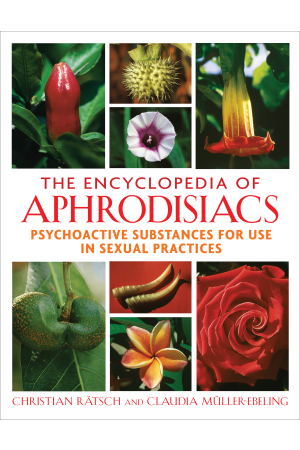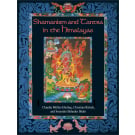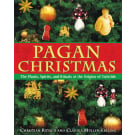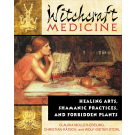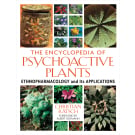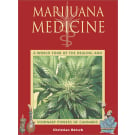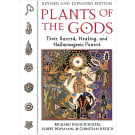The Encyclopedia of Aphrodisiacs
Psychoactive Substances for Use in Sexual Practices
By (Author) Christian Rätsch
By (Author) Claudia Müller-Ebeling
Availability:
In Stock
- Pages: 736
- Book Size: 8.5 x 11
- ISBN-13: 9781594771699
- Imprint: Park Street Press
- On Sale Date: February 3, 2013
- Format: Hardcover Book
- Illustrations: Full-color throughout
This stunning encyclopedia examines the botany, pharmacology, history, preparation, dosage, and practical use of more than 400 erotically stimulating substances from antiquity to the present day. Richly illustrated with more than 800 color photographs.
The most comprehensive guide to the botany, pharmacology, cultural, ritual, and personal use of erotically stimulating substances from antiquity to the present day
• Details the use, preparation, and dosage of more than 400 plant, animal, mineral, and synthetic substances, both common and exotic, as well as their botany, science, and legal status
• Explores the historical and present use of aphrodisiacs and their role in sexual practices, culture, and art
• Richly illustrated throughout with more than 800 color photographs
The culmination of more than 30 years of cultural, anthropological, and scientific research, this encyclopedia examines the botany, pharmacology, history, preparation, dosage, and practical use of more than 400 erotically stimulating substances from antiquity to the present day.
From plants and animals that enhance fertility and virility, like celery, snails, or oysters, to substances that induce arousal, like ephedra, opium, or cannabis, the encyclopedia is richly illustrated with more than 800 color photographs--many of which are from the authors’ extensive fieldwork around the world. Exploring individual, medicinal, and ritual use through historic and contemporary artwork, personal accounts, and literature as well as ayurvedic, tantric, shamanic, and European folklore practices and recent pharmacological research, the authors look at the revolving cycle of acceptance and condemnation of aphrodisiacs, the qualities that incur the label of “aphrodisiac,” the role of mind and setting, and the different ways aphrodisiacs stimulate desire--either physically, through the senses and vital organs, or mentally, through heightened awareness and altered consciousness. This comprehensive guide reveals these “remedies of the love goddess” as holy remedies whose proper use can help reestablish harmony with oneself, one’s partner, and the universe.
• Details the use, preparation, and dosage of more than 400 plant, animal, mineral, and synthetic substances, both common and exotic, as well as their botany, science, and legal status
• Explores the historical and present use of aphrodisiacs and their role in sexual practices, culture, and art
• Richly illustrated throughout with more than 800 color photographs
The culmination of more than 30 years of cultural, anthropological, and scientific research, this encyclopedia examines the botany, pharmacology, history, preparation, dosage, and practical use of more than 400 erotically stimulating substances from antiquity to the present day.
From plants and animals that enhance fertility and virility, like celery, snails, or oysters, to substances that induce arousal, like ephedra, opium, or cannabis, the encyclopedia is richly illustrated with more than 800 color photographs--many of which are from the authors’ extensive fieldwork around the world. Exploring individual, medicinal, and ritual use through historic and contemporary artwork, personal accounts, and literature as well as ayurvedic, tantric, shamanic, and European folklore practices and recent pharmacological research, the authors look at the revolving cycle of acceptance and condemnation of aphrodisiacs, the qualities that incur the label of “aphrodisiac,” the role of mind and setting, and the different ways aphrodisiacs stimulate desire--either physically, through the senses and vital organs, or mentally, through heightened awareness and altered consciousness. This comprehensive guide reveals these “remedies of the love goddess” as holy remedies whose proper use can help reestablish harmony with oneself, one’s partner, and the universe.
Chili Pepper
Capsicum spp., Solanaceae (nightshades)
In the West there are the following types and their cultivated forms:
Capsicum annuum L., wild chili shrub
Capsicum annuum L. var. abreviatum Fingh., Chilaile
Capsicum annuum L. var. grossum Sendt., Chile amash
Capsicum annuum L. var. longum Sentd.
Capsicum frutescens L., Chile de árbol
Capsicum frutescens L. var. grossum, paprika*
Capsicum pendulum Willd.
Other Names
Aji, Axi Bolol (Maya Yucateco), Cahuas (Taraskisch), Cahuasa, Calcuttischer apfeffer, Cancol (Tepehuano), Calcuttischer Pfeffer, Cancol (Tepehuano), Cayennepfeffer, Chil, Chilli, Chilipfeffer, Có’ocori (Mayo), Cucúrite (Huichol), Dya-ah, (mixtek), Guiná (Zapotek), Guiñá, Gu’ucuri (Cora), Hachik (Lakandon), Hungarian pepper, Ich (Tzeltal), Iich (Chol), Ik (Maya), Indianisher Pfeffer, Itz (huaxtek), Marichiphalam (Sanskrit), Mexican pepper, Mibi (Popoloca), Nigui, Nill (Mixe), Niy (Mixe), Ñi (Otomi), Pau (Chinantek), Peruvian pepper (Eng.), Pica, Pica-Pica, Pi’n (Totonak), Shimapite (Tarask), Spanischer Pfefer, Spanishpfeffer, Tabasco, Uchu (Quechua), Wayc’a (Aymara), Xubala (Yucatán)
The chili pepper is the hottest of all spices--no surprise, then, that it should be used to spice things up! The name chili comes from the Aztec chilli and means “spicy, spiciness.” Many Amerindian peoples place the chili in its own separate food category: “Heat for food.” But they also use it to heat up sexual activity, as a warming or red-hot aphrodisiac.
Uses
In the American tropics there are many (about 40) species and cultivars of chili or chili pepper, which are mostly used as spices (Andrews 1992 ). Besides their culinary application, chilis also have ethnomedicinal and ritual significance (Long-Solís 1986). The fruits are used to treat various illnesses and have antibacterial properties (Cichewicz and Thorpe 1996). At high doses (30-125 mg) chili is an aphrodisiac (Gottlieb 1974: 19). It is possible that chili peppers may have psychoactive effects in certain circumstances, for example at very high doses or when applied nasally. In any case, chilis are used as additives in various psychoactive products, such as ayahuasca, balche’, beer cacao, kava-kava, incense, and snuff powders (Weil 1976). The Kakusi Indians of Guyana use Capsicum sp. as stimulants and aphrodisiacs (Schultes 1967: 41). The women give chilis to men who are too strongly intoxicated by ayahuasca in order to “bring them down” (Schultes and Raffauf 1991: 35).
When chilis were first brought to Europe their qualities were compared to those of pepper. They were considered to be significantly hotter but to have similar lasting, stimulating, aphrodisiac effects (e.g., according to Fuchs 1543). In India the same conclusion was reached: “Cayenne has similar qualities to those of black pepper, but has a stronger short-term effect and a weaker longterm effect. This plant has rajah-like qualities and can, when taken excessively, lead to mental disturbances” (Lao and Frawley 1987: 161).
Chili pepper (Capsicum annuum) is added as a spice to various beverages. Even today Indians use it to flavor maize beers and add it to an aphrodisiac tequila. It is also an ingredient in the Mexican national recipe pollo con mole (chicken in chocolate sauce; cf. cacao). This hot and spicy sauce is entirely unlike our idea of chocolate as a sweet.
Chili pepper is also mixed into incense, for example along with cacao pods. The heating power of the chili is effective not only against a weak stomach and lack of energy; its stimulating and “mentally disturbing” force is also used to combat laziness in children, by burning the incense nearby (Bastien 1987: 101).
In homeopathy, Capsicum is used at varying strengths to treat impotence, among other things. For aphrodisiac purposes, most doses should consist of 25 to 125 mg chili powder, preferably enclosed in gelatin capsules (Stark 1984: 113).
Chili burns
Handling chilis can easily lead to burns. When chili gets in the eyes, according to Indian medicine the only effective treatment is the hair from one’s own head. In most Indian cultures, hair is worn long* and so can easily be used to wipe the eyes. The effect is amazing (and thus it is also recommended as a remedy for chefs and for people who cook at home). The hair removes the spicy substance from the mucous membranes.
Constituents
All species of the Capsicum genus contain the spicy chemical capsaicin (chemically related to vanillin) (Weil 1976). Other capsaicinoids are also present, as well as carotinide, fatty acids, and a large amount of vitamin C. Some species contain flavonoids. Capsicum annuum L. contains steroidal alkaloids and glycosides (Schultes and Raffauf 1991: 35).
*In the “drug scene,” the dried remains of rotten green paprika fruit (Capsicum frutescens vasr. grossum) are sometimes used as a marijuana substitute (see hemp, incense blends).
*The saying “long hair, short mind” became popular in Europe among generations that felt threatened by rebellious, long-haired youths. Conversely (and as a result of quite a different value system), in several Indian languages, a “right” person is someone with long hair.
Sources
Chili peppers of various types and origins can be found in produce markets, supermarkets, specialty shops, and Asian groceries.
Literature
Andrews, Jean. 1992. “The Peripatetic Chili Pepper: Diffusion of the Domesticated Capsicums Since Columbus,” in Nelson Foster and Linda S Cordell (Hg.), Chilies to Chocolate: Food the Americas Gave the World. Tucson and London: The University of Arizona Press, S. 81-93.
Cichewicz, Robert H., and Patrick A. Thorpe. 1996. “The Antimicrobial Properties of Chile Peppers (Capsicum Species) and Their Uses in Mayan Medicine.” Journal of Ethnopharmacology 52: 61-70.
Long-Solis, Janet. 1986. Capsicum y cultura: La historia del chilli. México, D.F.: Fondo de Cultura Económica.
Waldmann, Werner, and Marion Zerbst. 1995. Chili, Mais und Kaktusfeigen, München: Hugendubel.
Weil, Andrew. 1976. “Hot! Hot!--I: Eating Chilies.” Journal of Psychedelic Drugs 8(1): 83-86.
Capsicum spp., Solanaceae (nightshades)
In the West there are the following types and their cultivated forms:
Capsicum annuum L., wild chili shrub
Capsicum annuum L. var. abreviatum Fingh., Chilaile
Capsicum annuum L. var. grossum Sendt., Chile amash
Capsicum annuum L. var. longum Sentd.
Capsicum frutescens L., Chile de árbol
Capsicum frutescens L. var. grossum, paprika*
Capsicum pendulum Willd.
Other Names
Aji, Axi Bolol (Maya Yucateco), Cahuas (Taraskisch), Cahuasa, Calcuttischer apfeffer, Cancol (Tepehuano), Calcuttischer Pfeffer, Cancol (Tepehuano), Cayennepfeffer, Chil, Chilli, Chilipfeffer, Có’ocori (Mayo), Cucúrite (Huichol), Dya-ah, (mixtek), Guiná (Zapotek), Guiñá, Gu’ucuri (Cora), Hachik (Lakandon), Hungarian pepper, Ich (Tzeltal), Iich (Chol), Ik (Maya), Indianisher Pfeffer, Itz (huaxtek), Marichiphalam (Sanskrit), Mexican pepper, Mibi (Popoloca), Nigui, Nill (Mixe), Niy (Mixe), Ñi (Otomi), Pau (Chinantek), Peruvian pepper (Eng.), Pica, Pica-Pica, Pi’n (Totonak), Shimapite (Tarask), Spanischer Pfefer, Spanishpfeffer, Tabasco, Uchu (Quechua), Wayc’a (Aymara), Xubala (Yucatán)
The chili pepper is the hottest of all spices--no surprise, then, that it should be used to spice things up! The name chili comes from the Aztec chilli and means “spicy, spiciness.” Many Amerindian peoples place the chili in its own separate food category: “Heat for food.” But they also use it to heat up sexual activity, as a warming or red-hot aphrodisiac.
Uses
In the American tropics there are many (about 40) species and cultivars of chili or chili pepper, which are mostly used as spices (Andrews 1992 ). Besides their culinary application, chilis also have ethnomedicinal and ritual significance (Long-Solís 1986). The fruits are used to treat various illnesses and have antibacterial properties (Cichewicz and Thorpe 1996). At high doses (30-125 mg) chili is an aphrodisiac (Gottlieb 1974: 19). It is possible that chili peppers may have psychoactive effects in certain circumstances, for example at very high doses or when applied nasally. In any case, chilis are used as additives in various psychoactive products, such as ayahuasca, balche’, beer cacao, kava-kava, incense, and snuff powders (Weil 1976). The Kakusi Indians of Guyana use Capsicum sp. as stimulants and aphrodisiacs (Schultes 1967: 41). The women give chilis to men who are too strongly intoxicated by ayahuasca in order to “bring them down” (Schultes and Raffauf 1991: 35).
When chilis were first brought to Europe their qualities were compared to those of pepper. They were considered to be significantly hotter but to have similar lasting, stimulating, aphrodisiac effects (e.g., according to Fuchs 1543). In India the same conclusion was reached: “Cayenne has similar qualities to those of black pepper, but has a stronger short-term effect and a weaker longterm effect. This plant has rajah-like qualities and can, when taken excessively, lead to mental disturbances” (Lao and Frawley 1987: 161).
Chili pepper (Capsicum annuum) is added as a spice to various beverages. Even today Indians use it to flavor maize beers and add it to an aphrodisiac tequila. It is also an ingredient in the Mexican national recipe pollo con mole (chicken in chocolate sauce; cf. cacao). This hot and spicy sauce is entirely unlike our idea of chocolate as a sweet.
Chili pepper is also mixed into incense, for example along with cacao pods. The heating power of the chili is effective not only against a weak stomach and lack of energy; its stimulating and “mentally disturbing” force is also used to combat laziness in children, by burning the incense nearby (Bastien 1987: 101).
In homeopathy, Capsicum is used at varying strengths to treat impotence, among other things. For aphrodisiac purposes, most doses should consist of 25 to 125 mg chili powder, preferably enclosed in gelatin capsules (Stark 1984: 113).
Chili burns
Handling chilis can easily lead to burns. When chili gets in the eyes, according to Indian medicine the only effective treatment is the hair from one’s own head. In most Indian cultures, hair is worn long* and so can easily be used to wipe the eyes. The effect is amazing (and thus it is also recommended as a remedy for chefs and for people who cook at home). The hair removes the spicy substance from the mucous membranes.
Constituents
All species of the Capsicum genus contain the spicy chemical capsaicin (chemically related to vanillin) (Weil 1976). Other capsaicinoids are also present, as well as carotinide, fatty acids, and a large amount of vitamin C. Some species contain flavonoids. Capsicum annuum L. contains steroidal alkaloids and glycosides (Schultes and Raffauf 1991: 35).
*In the “drug scene,” the dried remains of rotten green paprika fruit (Capsicum frutescens vasr. grossum) are sometimes used as a marijuana substitute (see hemp, incense blends).
*The saying “long hair, short mind” became popular in Europe among generations that felt threatened by rebellious, long-haired youths. Conversely (and as a result of quite a different value system), in several Indian languages, a “right” person is someone with long hair.
Sources
Chili peppers of various types and origins can be found in produce markets, supermarkets, specialty shops, and Asian groceries.
Literature
Andrews, Jean. 1992. “The Peripatetic Chili Pepper: Diffusion of the Domesticated Capsicums Since Columbus,” in Nelson Foster and Linda S Cordell (Hg.), Chilies to Chocolate: Food the Americas Gave the World. Tucson and London: The University of Arizona Press, S. 81-93.
Cichewicz, Robert H., and Patrick A. Thorpe. 1996. “The Antimicrobial Properties of Chile Peppers (Capsicum Species) and Their Uses in Mayan Medicine.” Journal of Ethnopharmacology 52: 61-70.
Long-Solis, Janet. 1986. Capsicum y cultura: La historia del chilli. México, D.F.: Fondo de Cultura Económica.
Waldmann, Werner, and Marion Zerbst. 1995. Chili, Mais und Kaktusfeigen, München: Hugendubel.
Weil, Andrew. 1976. “Hot! Hot!--I: Eating Chilies.” Journal of Psychedelic Drugs 8(1): 83-86.
Preface
Introduction
What Are Aphrodisiacs?
Aphrodite and Venus
What Are “Agents of Pleasure”?
What Is an “Intoxicant” or “Addictive Drug”?
How Does One Use Aphrodisiacs?
On Expectations, Disappointments, and Desires
How Do Aphrodisiacs Work?
Dosage, Set, and Setting
Who’s Afraid of Aphrodisiacs?
On Desire and Its Demonization
How Did It Come to This?
The Five Senses--Our Sources of Erotic Experience
Vision
Hearing
Touch
Smell
Taste
Fire, Water, Air, and Earth
To Experience with All of Our Senses?
Which Senses Are Still with Us?
The Forgotten Sixth or Seventh Sense
The Power of the Senses over the Course of Time
Aphrodisiacs in Art
Grape, Vine, and Wine
Poppies and Opium
Hemp, Cannabis, and Hashish
Coca Leaves and Cocaine
The True Character of Aphrodisiacs in Art
A Look at Aphrodisiacs Today
Aphrodisiacs and Morality in Art
Eroticism in the Art of Polytheistic Cultures
Eroticism in the Art of Monotheistic Cultures
The Perception of Eroticism, Sexuality, and Aphrodisiacs--Beyond Art
The Encyclopedia from A to Z
The Structure of the Monographs
Pharmacratica Aphrodisiae: Legal Issues
About the Images
Appendix. A Short History of Books on the Topic of Aphrodisiacs and Love Agents
Bibliography
Resources
Acknowledgments
Index
CHRISTIAN RÄTSCH, Ph.D. (1957 – 2022), was a world-renowned anthropologist and ethnopharmacologist who specialized in the shamanic uses of plants for spiritual as well as medicinal purposes. He studied Mesoamerican languages and cultures and anthropology at the University of Hamburg, receiving his doctorate with a thesis on healing spells and incantations of the Lacandon-Maya people after three years of fieldwork among the Lacandon in Chiapas, Mexico. In addition to his work in Mexico, his numerous fieldworks have included research in Thailand, Bali, the Seychelles, and, with coauthor Claudia Müller-Ebeling, a long-term 18-year study on shamanism in Nepal combined with expeditions to Korea and the Peruvian and Colombian Amazon. Before becoming a full-time author and internationally renowned lecturer, Rätsch worked as professor of anthropology at the University of Bremen and served as consultant advisor for many German museums. Because of his extensive collection of shells, fossils, artifacts and entheopharmacological items, he had numerous museum expositions on these topics. A former president of the Association of Ethnomedicine, he is the author of numerous articles and more than 40 books, including The Encyclopedia of Psychoactive Plants and Marijuana Medicine, and is a coauthor of Plants of the Gods. CLAUDIA MÜLLER-EBELING, Ph.D., is an art historian and anthropologist and coauthor, with Christian Rätsch, of Shamanism and Tantra in the Himalayas, Witchcraft Medicine, and Pagan Christmas as well as a number of articles and books in German. In addition to her long-term anthropological fieldwork in Nepal, Korea, and the Peruvian and Colombian Amazon, she has worked as an art historian at the Hamburg Museum of Arts and Crafts and taught at the Hamburg Institute of Ethnology. She is one of the founders of Psycho Activity, an organization based in Amsterdam that seeks to preserve ancestral shamanic traditions by working with elders from around the world and distributing their wisdom globally. Both authors are former members of the board of advisors of the European College for the Study of Consciousness and regularly gave lectures throughout the world on shamanism, ethnobotany, and indigenous spiritual and healing traditions. Claudia lives in Hamburg, Germany.
“A treasure house of esoteric lore and delightful tidbits of erotica . . . well illustrated and intricately cross-referenced, it is a useful companion for the researcher, aficionado, dabbler, or just plain interested [beginner].”
The Journal of Divine Ecstasy
“An elegant, unsentimental, and extraordinary book. From photographs of African fertility dances to full tantrik instructions, from French phallic ancient stone monuments to a discussion of pheromones, this is the best of its kind I've seen. Highly recommended.”
Yellow Silk
“Aside from the erotic implications, sexual energy is the universe’s great rejuvenator, making this a good reference tool for intellectually inclined energy workers. It will also interest those who seriously study ancient goddess tradition. Consider displaying it strategically to boost sales of essential oils, incense, candles, and even jewelry (agate, jade, and amber are all considered aphrodisiacs).”
Anna Jedrziewski, Retailing Insight, December 2011
“Three decades of cultural and scientific research inform this panoramic assembly of all substances sexually stimulating. From abalone to zinc, more than 400 lust-inspiring vegetable, animal, mineral, and man-made materials are profiled by the anthropologist authors, with explanations on methods of use, preparation and dosage. Also discussed is their legality and place in history. Including 800 color photographs...this is a valuable and unusual resource. Verdict Containing commentary from the authors’ experiences as well as ‘personal reports of friends and colleagues,’ this tome is a genuine labor of love.”
Christina Connolly, Library Journal, December 2012
“In creating this book, Christian Rätsch and Claudia Müller-Ebeling have joined a growing chorus of perceptive voices insisting that our inherent sexual nature not only be accepted but also embraced, for it is an essential element of our humanness. Their supportive look at the wide range and nature of aphrodisiacs is a welcome addition to the growing body of knowledge of our human exploration of pleasure.”
Stephen Harrod Buhner, author of The Secret Teachings of Plants
“The Encyclopedia of Aphrodisiacs is a sensuous and colorful compendium of plants and potions that invigorate the senses and nourish the body, turning one’s thoughts and actions toward love, pleasure, and passion. Full of mystery, magic, myth, and science, this book opens the doors to a world of time-tested remedies that help us rise to our full potential as amazing lovers of life.”
Brigitte Mars, author of The Sexual Herbal
“A comprehensive and scholarly work exploring humanity’s extensive use of ‘Agents of the Love Goddess.’ A superb job of presenting the often taboo subject of aphrodisiacs in the light of pharmacology, herbalism, and human sexuality.”
David Hoffmann, FNIMH, RH, cofounder of the American Herbalist Guild and author of Medical Herbalism
The Journal of Divine Ecstasy
“An elegant, unsentimental, and extraordinary book. From photographs of African fertility dances to full tantrik instructions, from French phallic ancient stone monuments to a discussion of pheromones, this is the best of its kind I've seen. Highly recommended.”
Yellow Silk
“Aside from the erotic implications, sexual energy is the universe’s great rejuvenator, making this a good reference tool for intellectually inclined energy workers. It will also interest those who seriously study ancient goddess tradition. Consider displaying it strategically to boost sales of essential oils, incense, candles, and even jewelry (agate, jade, and amber are all considered aphrodisiacs).”
Anna Jedrziewski, Retailing Insight, December 2011
“Three decades of cultural and scientific research inform this panoramic assembly of all substances sexually stimulating. From abalone to zinc, more than 400 lust-inspiring vegetable, animal, mineral, and man-made materials are profiled by the anthropologist authors, with explanations on methods of use, preparation and dosage. Also discussed is their legality and place in history. Including 800 color photographs...this is a valuable and unusual resource. Verdict Containing commentary from the authors’ experiences as well as ‘personal reports of friends and colleagues,’ this tome is a genuine labor of love.”
Christina Connolly, Library Journal, December 2012
“In creating this book, Christian Rätsch and Claudia Müller-Ebeling have joined a growing chorus of perceptive voices insisting that our inherent sexual nature not only be accepted but also embraced, for it is an essential element of our humanness. Their supportive look at the wide range and nature of aphrodisiacs is a welcome addition to the growing body of knowledge of our human exploration of pleasure.”
Stephen Harrod Buhner, author of The Secret Teachings of Plants
“The Encyclopedia of Aphrodisiacs is a sensuous and colorful compendium of plants and potions that invigorate the senses and nourish the body, turning one’s thoughts and actions toward love, pleasure, and passion. Full of mystery, magic, myth, and science, this book opens the doors to a world of time-tested remedies that help us rise to our full potential as amazing lovers of life.”
Brigitte Mars, author of The Sexual Herbal
“A comprehensive and scholarly work exploring humanity’s extensive use of ‘Agents of the Love Goddess.’ A superb job of presenting the often taboo subject of aphrodisiacs in the light of pharmacology, herbalism, and human sexuality.”
David Hoffmann, FNIMH, RH, cofounder of the American Herbalist Guild and author of Medical Herbalism
HERBAL REMEDIES
“A comprehensive and scholarly work exploring humanity’s extensive use of ‘Agents of the Love Goddess.’ A superb job of presenting the often taboo subject of aphrodisiacs in the light of pharmacology, herbalism, and human sexuality.”
--David Hoffmann, FNIMH, RH, cofounder of the American Herbalist Guild and author of Medical Herbalism
“In creating this book, Christian Rätsch and Claudia Müller-Ebeling have joined a growing chorus of perceptive voices insisting that our inherent sexual nature not only be accepted but also embraced, for it is an essential element of our humanness. Their supportive look at the wide range and nature of aphrodisiacs is a welcome addition to the growing body of knowledge of our
human exploration of pleasure.”
--Stephen Harrod Buhner, author of The Secret Teachings of Plants
The culmination of more than 30 years of cultural, anthropological, and scientific research, this encyclo-pedia examines the botany, pharmacology, history, preparation, dosage, and practical use of more than 500 erotically stimulating substances from antiquity to the present day.
Around the globe, there are countless numbers of plants and substances said to stimulate and enhance love, lust, and passion or to intensify it to the level of mystical experience. The word for these “agents of pleasure”--aphrodisiacs--refers to the Greek goddess of love and beauty, Aphrodite. Through detailed monographs on each aphrodisiac, the authors explain the beliefs behind culturally specific aphrodisiacs and reveal the ayurvedic, tantric, shamanic, and European folklore practices and recent pharmacological research associated with them. They provide examples of individual, medicinal, and ritual use through historic and contemporary artwork, personal accounts, and literature. The authors look at the revolving cycle of acceptance and condemnation of aphrodisiacs throughout history--from the Ars Amatoria (The Art of Love) by Ovid (43 B.C.E-18 C.E.) and Vatsyana’s Kama Sutra (4th century C.E.) to the 15th-century treatise on love Al-Rawd Al-Atir by Sheik Nefzaui, the classic that was translated into English by Sir Richard Burton as The Perfumed Garden in 1886, to the contemporary Aphrodisiaca, one of the first attempts to classify aphrodisiacs using a pharmaceutical/chemical standard, published in Berlin in 1930 and destroyed by the Nazis when they took power. The authors also present the important role played by mind and setting and explain in depth the different ways aphrodisiacs stimulate desire and erotic experience: either physically, through the senses and vital organs, or mentally, through heightened awareness and altered consciousness.
From plants and animals that enhance fertility and virility, such as asparagus, snails, or oysters, to substances that induce arousal, such as ephedra, opium, or cannabis, to erotic objects, such as bones, gems, or conch shells, the encyclopedia is richly illustrated with more than 800 color photographs--many of which come from the authors’ extensive fieldwork around the world. This comprehensive guide reveals aphrodisiacs as holy remedies whose proper use can help reestablish harmony with oneself, one’s partner, and the universe.
CHRISTIAN RÄTSCH, Ph.D. (1957 – 2022), was a world-renowned anthropologist and ethnopharmacologist who specialized in the shamanic uses of plants for spiritual as well as medicinal purposes. He studied Mesoamerican languages and cultures and anthropology at the University of Hamburg, receiving his doctorate with a thesis on healing spells and incantations of the Lacandon-Maya people after three years of fieldwork among the Lacandon in Chiapas, Mexico. In addition to his work in Mexico, his numerous fieldworks have included research in Thailand, Bali, the Seychelles, and, with coauthor Claudia Müller-Ebeling, a long-term 18-year study on shamanism in Nepal combined with expeditions to Korea and the Peruvian and Colombian Amazon. Before becoming a full-time author and internationally renowned lecturer, Rätsch worked as professor of anthropology at the University of Bremen and served as consultant advisor for many German museums. Because of his extensive collection of shells, fossils, artifacts and entheopharmacological items, he had numerous museum expositions on these topics. A former president of the Association of Ethnomedicine, he is the author of numerous articles and more than 40 books, including The Encyclopedia of Psychoactive Plants and Marijuana Medicine, and is a coauthor of Plants of the Gods. CLAUDIA MÜLLER-EBELING, Ph.D., is an art historian and anthropologist and coauthor, with Christian Rätsch, of Shamanism and Tantra in the Himalayas, Witchcraft Medicine, and Pagan Christmas as well as a number of articles and books in German. In addition to her long-term anthropological fieldwork in Nepal, Korea, and the Peruvian and Colombian Amazon, she has worked as an art historian at the Hamburg Museum of Arts and Crafts and taught at the Hamburg Institute of Ethnology. She is one of the founders of Psycho Activity, an organization based in Amsterdam that seeks to preserve ancestral shamanic traditions by working with elders from around the world and distributing their wisdom globally. Both authors are former members of the board of advisors of the European College for the Study of Consciousness and regularly gave lectures throughout the world on shamanism, ethnobotany, and indigenous spiritual and healing traditions. Claudia lives in Hamburg, Germany.
“A comprehensive and scholarly work exploring humanity’s extensive use of ‘Agents of the Love Goddess.’ A superb job of presenting the often taboo subject of aphrodisiacs in the light of pharmacology, herbalism, and human sexuality.”
--David Hoffmann, FNIMH, RH, cofounder of the American Herbalist Guild and author of Medical Herbalism
“In creating this book, Christian Rätsch and Claudia Müller-Ebeling have joined a growing chorus of perceptive voices insisting that our inherent sexual nature not only be accepted but also embraced, for it is an essential element of our humanness. Their supportive look at the wide range and nature of aphrodisiacs is a welcome addition to the growing body of knowledge of our
human exploration of pleasure.”
--Stephen Harrod Buhner, author of The Secret Teachings of Plants
The culmination of more than 30 years of cultural, anthropological, and scientific research, this encyclo-pedia examines the botany, pharmacology, history, preparation, dosage, and practical use of more than 500 erotically stimulating substances from antiquity to the present day.
Around the globe, there are countless numbers of plants and substances said to stimulate and enhance love, lust, and passion or to intensify it to the level of mystical experience. The word for these “agents of pleasure”--aphrodisiacs--refers to the Greek goddess of love and beauty, Aphrodite. Through detailed monographs on each aphrodisiac, the authors explain the beliefs behind culturally specific aphrodisiacs and reveal the ayurvedic, tantric, shamanic, and European folklore practices and recent pharmacological research associated with them. They provide examples of individual, medicinal, and ritual use through historic and contemporary artwork, personal accounts, and literature. The authors look at the revolving cycle of acceptance and condemnation of aphrodisiacs throughout history--from the Ars Amatoria (The Art of Love) by Ovid (43 B.C.E-18 C.E.) and Vatsyana’s Kama Sutra (4th century C.E.) to the 15th-century treatise on love Al-Rawd Al-Atir by Sheik Nefzaui, the classic that was translated into English by Sir Richard Burton as The Perfumed Garden in 1886, to the contemporary Aphrodisiaca, one of the first attempts to classify aphrodisiacs using a pharmaceutical/chemical standard, published in Berlin in 1930 and destroyed by the Nazis when they took power. The authors also present the important role played by mind and setting and explain in depth the different ways aphrodisiacs stimulate desire and erotic experience: either physically, through the senses and vital organs, or mentally, through heightened awareness and altered consciousness.
From plants and animals that enhance fertility and virility, such as asparagus, snails, or oysters, to substances that induce arousal, such as ephedra, opium, or cannabis, to erotic objects, such as bones, gems, or conch shells, the encyclopedia is richly illustrated with more than 800 color photographs--many of which come from the authors’ extensive fieldwork around the world. This comprehensive guide reveals aphrodisiacs as holy remedies whose proper use can help reestablish harmony with oneself, one’s partner, and the universe.
CHRISTIAN RÄTSCH, Ph.D. (1957 – 2022), was a world-renowned anthropologist and ethnopharmacologist who specialized in the shamanic uses of plants for spiritual as well as medicinal purposes. He studied Mesoamerican languages and cultures and anthropology at the University of Hamburg, receiving his doctorate with a thesis on healing spells and incantations of the Lacandon-Maya people after three years of fieldwork among the Lacandon in Chiapas, Mexico. In addition to his work in Mexico, his numerous fieldworks have included research in Thailand, Bali, the Seychelles, and, with coauthor Claudia Müller-Ebeling, a long-term 18-year study on shamanism in Nepal combined with expeditions to Korea and the Peruvian and Colombian Amazon. Before becoming a full-time author and internationally renowned lecturer, Rätsch worked as professor of anthropology at the University of Bremen and served as consultant advisor for many German museums. Because of his extensive collection of shells, fossils, artifacts and entheopharmacological items, he had numerous museum expositions on these topics. A former president of the Association of Ethnomedicine, he is the author of numerous articles and more than 40 books, including The Encyclopedia of Psychoactive Plants and Marijuana Medicine, and is a coauthor of Plants of the Gods. CLAUDIA MÜLLER-EBELING, Ph.D., is an art historian and anthropologist and coauthor, with Christian Rätsch, of Shamanism and Tantra in the Himalayas, Witchcraft Medicine, and Pagan Christmas as well as a number of articles and books in German. In addition to her long-term anthropological fieldwork in Nepal, Korea, and the Peruvian and Colombian Amazon, she has worked as an art historian at the Hamburg Museum of Arts and Crafts and taught at the Hamburg Institute of Ethnology. She is one of the founders of Psycho Activity, an organization based in Amsterdam that seeks to preserve ancestral shamanic traditions by working with elders from around the world and distributing their wisdom globally. Both authors are former members of the board of advisors of the European College for the Study of Consciousness and regularly gave lectures throughout the world on shamanism, ethnobotany, and indigenous spiritual and healing traditions. Claudia lives in Hamburg, Germany.



